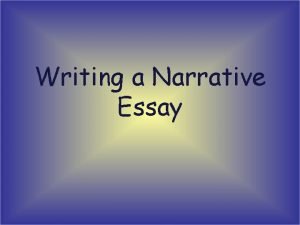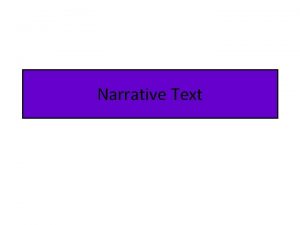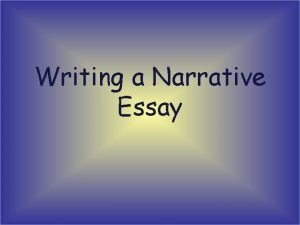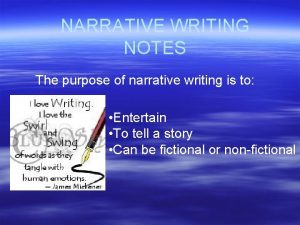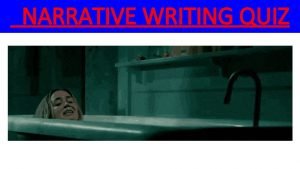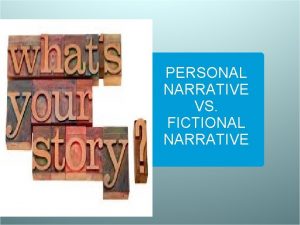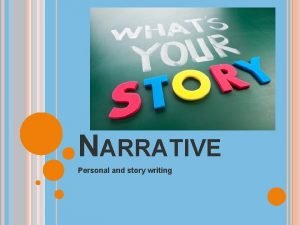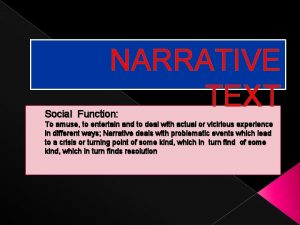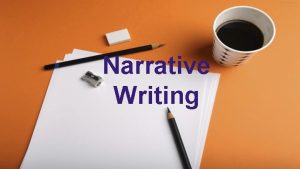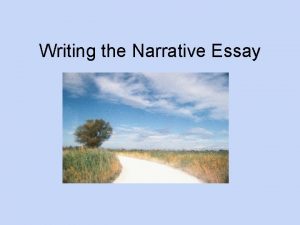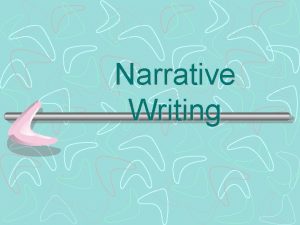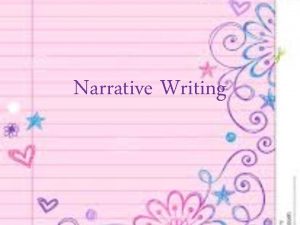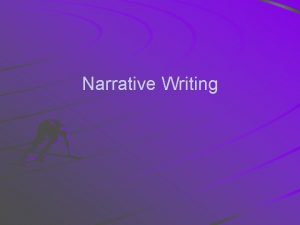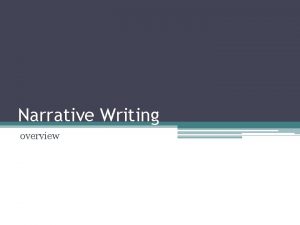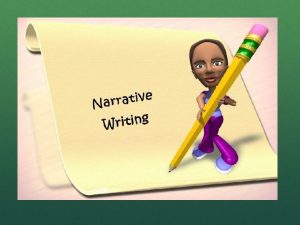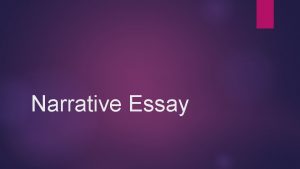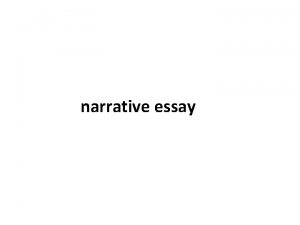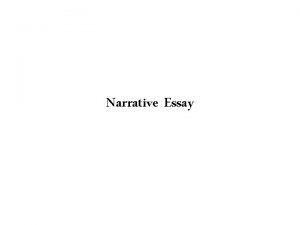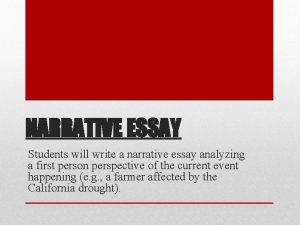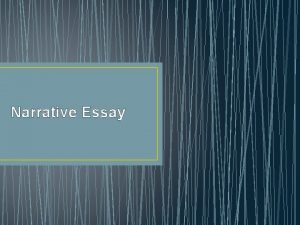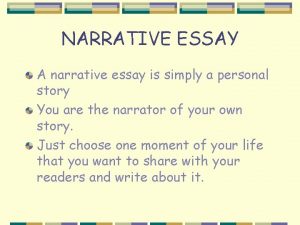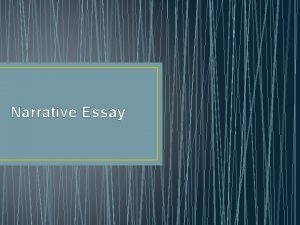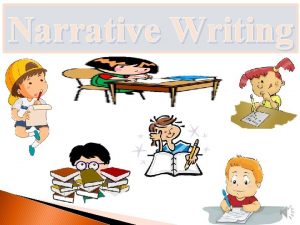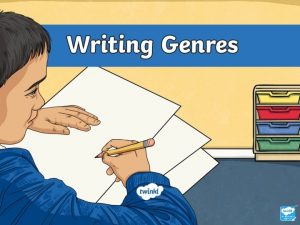Writing a Narrative Essay The Purpose of a






















- Slides: 22

Writing a Narrative Essay

The Purpose of a Narrative • To tell a story about a personal experience – Describe the experience in detail – Don’t tell the reader ~ SHOW them what happened. The reader should feel like they are in the experience because your details are so vivid!

Format • • 1 st Person 8 -10 Sentences per body paragraph New event = new paragraph Events described in chronological order • Elaborate ~ do NOT list events!

Format • Use personal feelings and emotions ~ for every event, give your reaction (how did you feel? ) • Describe things using all of your senses • Closing paragraph is NOT a conclusion ~ it is an overall reflection to the event

Overall • Use transitions (words and phrases) to link ideas and paragraphs • Use strong / vivid words • Use complex, compound, and detailed sentences

Topic for Narrative • We will all be writing on the same topic for your 1 st narrative. This will allow everyone in the class to follow along as we discuss how each portion of the narrative is written. • The topic is : What unexpected event shows how a person can influence someone from a different generation? • This will be about you so think about how someone had an influence on you and what knowledge or skills you gained from them.

The Tell – Show Strategy �

Remember When … • You probably remember “show and tell” from kindergarten….

What if you forgot to bring something? • You would still want to tell your friends about your special item • You’d have to “show” them with your words

Showing is Better than Telling • Showing is more specific • Showing helps readers make a picture in their minds • Showing is more interesting than telling

What is the Difference? • Showing includes the details – – Using Your Senses – Feeling Words – Similes and Metaphor – Focuses the Reader on the Most Important Parts

Example: Telling My basketball game was exciting. Showing It all came down to the final few seconds. The scoreboard flashed the close score in bright red. Our team was behind one point, 57 -56. While the crowd roared, our coach called time out from the sidelines to set up a play. We were going to go for one shot. My friend Robert was supposed to take it. (He’s our best outside shooter. ) Unfortunately, something went wrong. As I prepared to throw the ball in, Robert was being blocked out by two players on the other team. For a split second I froze not knowing what to do. Then I realized if I didn’t throw it in quickly, the ref would blow his whistle, giving possession to the other team. Swiftly, I flung the ball as hard as I could towards the basket.

The Strategy • Start with the simple sentence • Use visualization to list everything you want to show • Compose detailed compound, complex sentences full of strong, vivid word choices.

Introduction – Must catch the readers attention immediately! – Use separate sentences to introduce ideas and events. Do not list the events. – Do not give away the story in the introduction, but rather leave the reader wanting more – Use transitions to introduce each new idea

Overall - Introduction • Introduction should be at least 5 sentences long • 1 catchy introduction sentence • 3 -4 ideas or events described separately • 1 hook to leave the reader wanting to read more

Introduction Guidelines Sentence # What you should write: 1 Attention Getter 2– 4 Introduce character(s), setting, and event = build the background DO NOT TELL THE STORY YET! 5 Hook: Leave the reader wondering “What happens next? ” Example hook: I rushed out the door with anticipation, having no idea what this exciting day would have in store for me.

A Sample Crash! That was the sound I heard in my head as the shadowy image hit me. I wasn’t sure what had just happened. One minute I was flying free like a bird; the next I was lying on the ground. As I began to wake from what seemed like imaginary visions, I realized that something wasn’t right. Would I, Adam Zebrin Martin better known as Zebra, ever be the same again?

Body Paragraphs – Must describe all ideas or events mentioned in the introduction in chronological order – these ideas/events are the “true” story and should further explain the introduction – Each idea/event should be a separate paragraph – Describe each idea/event in a detailed explanation using feelings, emotions, and senses. Make the reader feel as if they were there also.

Body Paragraphs – Use transitions (words or phrases) to start each new paragraph and each new idea *use transition sheet provided for suggestions – Each paragraph should be at least 8 -10 sentences, but all body paragraphs should be equal length

A Sample Throughout the chaotic scene, one thing raced through my mind, “Was I just hit by a car? ”. As I finally began to sort through the events, I realized that when I felt like I was soaring like a bird I wasn’t paying attention. Rather than running like I usually did, I had gained more momentum and began to fly. Immediately, I now realized that the shadowy image that had appeared was a car. With this in mind, I glanced at the nearby pedestrians beginning to come forward. As they asked me if I was okay, I couldn’t respond; it was like I was in a dream. Fear began to grow inside me. I wondered what would happen if I couldn’t run again? This thought lingered in my mind as I began to realize that a crowd had formed around me. Finally, with agonizing pain, I tried to move.

Final Paragraph Guidelines – Not a conclusion! Instead use the final paragraph to wrap up the story – DO NOT RESTATE previous events! – Look back and REFLECT on the overall experience – You should unify (tie together) the whole essay – Include overall feelings about the whole event – has it changed you in any way?

A Sample As it turns out, even though I am unable to run like I use to, I am still Zebra. Throughout this experience I have had to learn to enjoy different activities. Although my first love will always be running, I can now look to the future with more enthusiasm. In the end, the day I chose to fly like a bird caused me to look at the negatives in life and the positives. I realized that by only focusing on the negative can cause a lifetime of pain, but the positives can create a bright future.
 Purpose of narrative writing
Purpose of narrative writing The purpose of the narrative text is ...
The purpose of the narrative text is ... Purpose of narrative essay
Purpose of narrative essay Notes on narrative writing
Notes on narrative writing Narrative essay
Narrative essay Should i write in first or third person quiz
Should i write in first or third person quiz Personal narrative vs fictional narrative
Personal narrative vs fictional narrative Personal narrative vs fictional narrative
Personal narrative vs fictional narrative What is the social function of a narrative text?
What is the social function of a narrative text? Hình ảnh bộ gõ cơ thể búng tay
Hình ảnh bộ gõ cơ thể búng tay Frameset trong html5
Frameset trong html5 Bổ thể
Bổ thể Tỉ lệ cơ thể trẻ em
Tỉ lệ cơ thể trẻ em Voi kéo gỗ như thế nào
Voi kéo gỗ như thế nào Tư thế worm breton
Tư thế worm breton Bài hát chúa yêu trần thế alleluia
Bài hát chúa yêu trần thế alleluia Môn thể thao bắt đầu bằng từ chạy
Môn thể thao bắt đầu bằng từ chạy Thế nào là hệ số cao nhất
Thế nào là hệ số cao nhất Các châu lục và đại dương trên thế giới
Các châu lục và đại dương trên thế giới Công thức tính độ biến thiên đông lượng
Công thức tính độ biến thiên đông lượng Trời xanh đây là của chúng ta thể thơ
Trời xanh đây là của chúng ta thể thơ Mật thư anh em như thể tay chân
Mật thư anh em như thể tay chân 101012 bằng
101012 bằng
